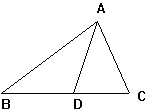![]() I. DISTANCE BETWEEN TWO POINTS AND POINT OF DIVISION
I. DISTANCE BETWEEN TWO POINTS AND POINT OF DIVISION
Find the distance between the given points (1-4):
1. (-4, -1), (6, -5) 2. (![]() , 1), (1, -
, 1), (1, -![]() ) 3. (0,0),
) 3. (0,0), 
4. ![]() ,
, ![]()
5. Given A=(2,0), B=(-2,0), C=(0,3), D=(0,-3). (a) Prove that ABCD is a rhombus
(b) Find the area of ABCD.
6. Given A=(1,4), B=(2,7), C=(-5,6). (a) Prove that ABC is a right-angled triangle.
(b) Find the area of triangle ABC.
7. The distance between the point (x,y) and (2,-4) is 5. Find the equation connecting x and y.
8. Find the coordinates of the point on the y-axis which is 5 units from the point A(3,-1).
9. A point on the x-axis is equidistant from the origin and the point B(8,4). Find the coordinates of the point.
10. Find the coordinates of the mid-points of the sides of triangle ABC with the vertices A(2,-3), B(4,0) and C(-2,-4).
11. If the vertices of triangle ABC are A(2,3), B(-4,1) and C(-6,-4), find that coordinates of the centroid of the triangle.
12. If G(-1/3, 10/3) is the centroid of triangle ABC and A=(1,2), B=(0,5), find the coordinates of the vertice C.
13. In a triangle ABC, A=(-3,-6), B=(-6,5) and C=(-3,5). Find the length of median AD.
14. Given that A=(1,1), B=(5,-3). AB is produced to point C such that AC=3.AB. Find the coordinates of C.
15. Given that A-(-1,1), B=(5,-3). P os an external point of division of AB such that PA:AB=2:5, Find the coordinates of point P.
16. The point C(2,3) divides the line segment AB in the ratio 1:2. If A=(1,2), find the coordinates of B.
17. Given that A=(1,6), B=(-3,4). If the line segment AB meets the x-axis at D, find the
(a) ratio AD:DB
(b) the coordinates of D.
18. The three vertices of parallelogram ABCD are A(1,1), B(2,2), C(3,-1). Find
(a) the coordinates of the intersecting point of the diagonals.
(b) the coordinates of D.
19. Point C and D are symmetric to the point B(-1,4) and A(-4,0) with respect to the y-axis.
(a) Plot the points A, B, C, D on a coordinate plane.
(b) Find the perimeter of quadrilateral ABCD.
(c) Find the area of quadrilateral ABCD.
20. (a) In the figure, AD is the bisector of angle BAC. Use the sine rule to prove that BD:DC=AB:AC.

(b) If the vertices of triangle ABC are A(4,1), B(7,5), C(-4,7), find:
(i) the value of BD:DC
(ii) the coordinates of D.
.ANSWERS: 1.![]() 2.
2. ![]() 3.(a) 4. |a-b| 5. 12 6.10 7.
3.(a) 4. |a-b| 5. 12 6.10 7. ![]() 8.
8.
(0,3),(0,5) 9. (5,0) 10.(0,-7/2), (1,-2), (3,-3/2) 11. (-8/3,0) 12. (-2,3) 13. ![]()
14. (13,-11) 15. (-17/5,13/5) 16. (4,5) 17.(a) 3/2 (b) (-7/5,0) 18. (a) (2,0) (b) 2,-2)
19. (b) 20 (c) 20 20. (b)(i) 1:2 (ii) (10/3,17/3).